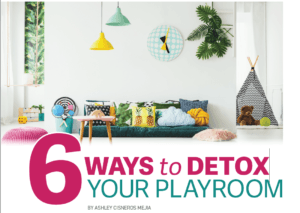
Published in the April 2019 issue of Nona Magazine, click here for PDF
With two small kids under the age of 5, I thank the good Lord above for their playroom. It’s the one place in the house where all the toys, books, crayons, Barbies, and seemingly endless blocks can just “be.” As a mamapreneur, it’s a must-have when it’s time for a conference call. If I can get the kids going on an activity in the playroom, I can *hopefully* count on at least 30 minutes of quiet time to get business done.
As much as I like to take the little ones to the park on breaks, I must admit that they spend a good amount of time indoors. We’re not unique. In fact, the Environmental Protection Agency (EPA) says that Americans spend approximately 90 percent of their time indoors.
Yet, unfortunately, the air quality in our homes can be downright dangerous. The chemicals in our furniture, the paint on our walls, fabrics in our homes, and furniture we lounge on can definitely expose us to toxic chemicals. And it’s the youngest members of our families who are affected most.
According to the Journal of Epidemiology and Community Health, “Infants and young children often have the highest exposures because of their activities (e.g., hand-to-mouth play on the floor) and physiology (e.g., higher breathing rates).”
How can you reduce your carbon footprint and protect the little feet that pitter patter around your home? Let’s start with the playroom.
Flooring
Playrooms are usually high-traffic areas, so floors are very important. The Environmental Working Group (EWG) suggests staying away from synthetic carpet and laminate vinyl flooring. Instead, consider:
– Forest Stewardship Council (FSC) certified solid wood
– Natural tile or linoleum made in the U.S.
– Low-volatile organic compound (VOC) finishes and sealants
– NAF-certified products
– Installing without glue; use nail-down or click-lock
What’s so bad about vinyl? According to Science News Magazine, “Children living in homes with all vinyl flooring had concentrations of a by-product of the plasticizer benzyl butyl phthalate in their urine of about 240 nanograms per milliliter on average. Meanwhile, kids living in homes with no vinyl flooring had only about 12 nanograms per milliliter on average.”
Though the figures resulting from the study technically fall below the EPA’s safety limits, this phthalate has been tied to both respiratory and reproductive disorders.
Paint
Whether you’ve rolled up your sleeves and painted your kids’ play area yourself or hired a professional, you know how smelly the process can be. The reason? Many paints and paint-related products release VOCs that can include a plethora of substances like acetate, formaldehyde, methylene chloride, and much more. According to the EPA, VOCs can cause everything from eye, nose and throat irritation to damage to the nervous system, liver and kidneys, and even cancer.
While many retailers have announced measures to stop selling certain paint thinners containing harmful chemicals, it pays to consider what type of paint products you use in your playroom. Check the labels of your paints and pick ones that are natural paints and zero-VOC. Natural paints are comprised of ingredients like citrus, soy oils, clay, chalk, and even milk, among others.
While zero-VOC paint still technically contains some solvents (otherwise it wouldn’t stick to the walls), this type is produced without the VOCs prohibited by the U.S. Clean Air Act. Another tip is to pick a lighter color for your playroom because lighter hues usually have lower VOC levels than darker colors. You can also search for the Green Seal Certification to ensure your paint is free from harmful carcinogens.
Drapes & Area Rugs
Before you Amazon some cute drapes or area rugs for your playroom, it’s a good idea to review their components. Most textiles are unfortunately laden with chemicals like formaldehyde, pesticides, chlorine and perfluorochemicals (PFCs) from their fabrics and dyes.
Buy natural fabrics when possible like organic cotton, wool, bamboo, silk and hemp. In addition, choose products that have been naturally colored or those that were treated with low-impact dye. Credible third-party labels to look for include GOTS (Global Organic Textile Standard) Certified, Oeko-Tex Standard 100, and USA Organic.
Furniture
When it comes to buying furniture for your little ones’ playroom, you may be considering tables, chairs and bookcases made of inexpensive particle board or medium-density fiberboard (MDF). While these options are usually affordable and pretty durable, they almost always contain some kind of pesticide and/or formaldehyde and can release gasses into your home for years.
When possible, look for solid wood pieces for your playroom. To keep it affordable, check out garage sales, second-hand stores, and buy-sell apps like LetGo, OfferUp, etc.
Toys
Let’s make our way over to the toy box, shall we? Here’s the deal – we have all bought or received plastic toys for our kids, many of which make wonderful noises (sarcasm here). Not only are these annoying, they can also be toxic. To make cheap toys, manufacturers have been known to use PVC, BPA, lead, phthalates, cadmium, chlorine and even arsenic.
To detox your toy chest, get rid of as many of the plastic items as you can. Instead, look for toys made of solid, non-toxic wood that’s either coated with a natural oil finish or simply unfished. For stuffed animals, opt for those that are certified organic or at least made from untreated, natural fibers.
Cleaning
Let’s face it. Kids can be gross, and while it’s tempting to disinfect your playroom like a hospital, the chemicals can wreak havoc on your family’s health. To keep your playroom clean, the Children’s Hospital of Philadelphia suggests using simple water and baking soda for surfaces and a mixture of 3 parts olive oil and 1 part white vinegar for furniture.
Use a HEPA-sealed vacuum to keep the floors clean and consider adding some air-purifying plants like a snake plant, English ivy plant, or a bamboo palm.
Creating a more eco-friendly home can seem overwhelming at first, but it doesn’t have to be. Start with one area of your home and take it slow. For more ideas on how to get started, check out the EWG’s Home Guide at: https://www.ewg.org/healthyhomeguide/




Leave A Comment